INTRODUCTION
You’re in the market for a bag of copepods (pods) but you’re stuck between choices. Company A claims a whopping number of pods, but its bag is virtually see-through. Company B’s bag looks promising, but it claims such a low pod number that you wonder if there are more “fillers” than pods. All too often, fish owners find themselves shot in the dark when it comes to knowing how many copepods they’re really getting. When purchasing pods, it’s important to keep in mind that live pods are in a constant cycle of growth and could vary in their sizes tremendously (FIGURES 1, 2, and 3), depending on the growth stage they’re in.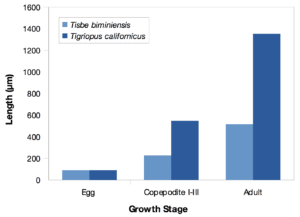 FIGURE 1: Variations in mean size (μm) from egg to adult in Tisbe biminiensis and Tigriopus californicus (Pinto, Souza-Santos, & Santos, 2001; Powlik, Lewis, & Spaeth, 1997)1. Depending on the pod’s growth stage, its body size can vary greatly. Eggs and copepodites can continue to progress through growth cycles while in storage and in the fish tank.
FIGURE 1: Variations in mean size (μm) from egg to adult in Tisbe biminiensis and Tigriopus californicus (Pinto, Souza-Santos, & Santos, 2001; Powlik, Lewis, & Spaeth, 1997)1. Depending on the pod’s growth stage, its body size can vary greatly. Eggs and copepodites can continue to progress through growth cycles while in storage and in the fish tank.
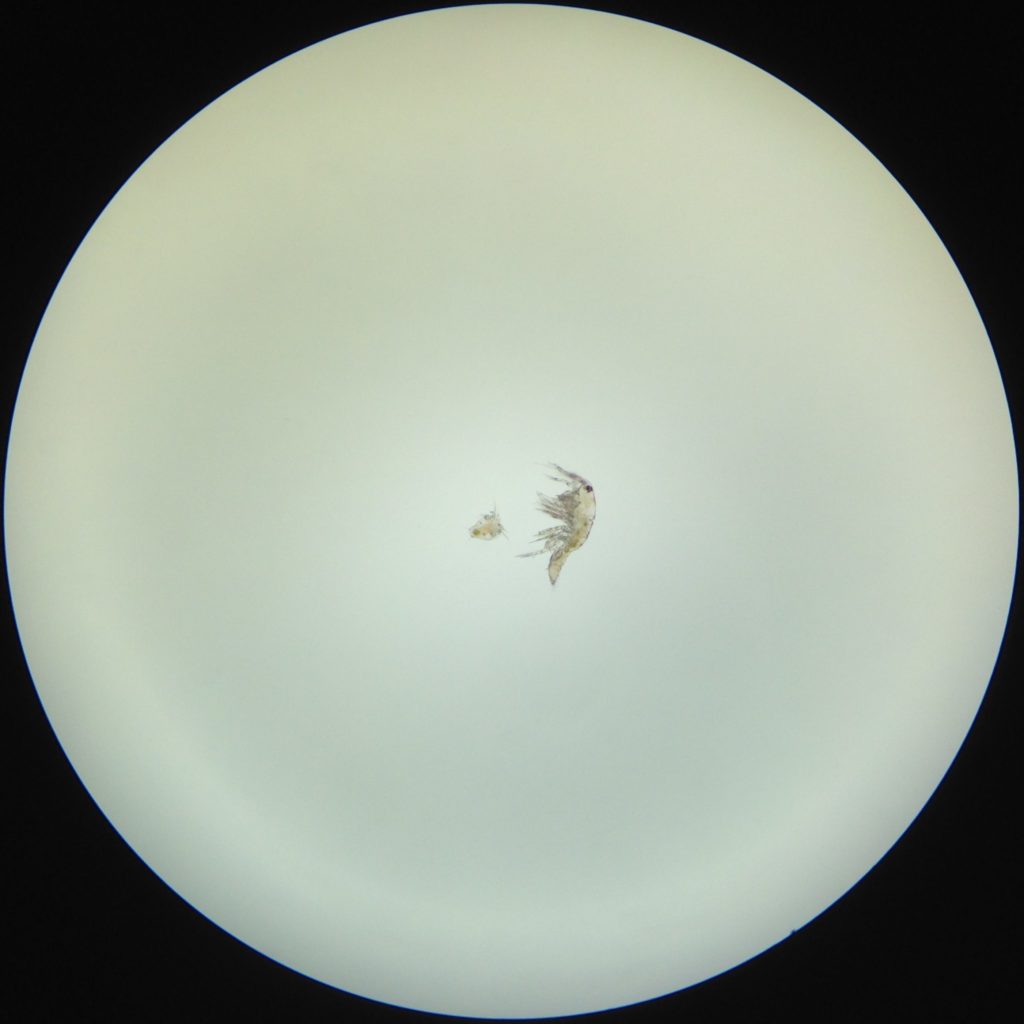 FIGURE 2: Size difference between Tigriopus californicus copepodite (left) and adult (right) from Poseidon’s Feast product line at 40X. Poseidon’s Feast bags are gas-permeable and include nutrients to maximize pod growth during shipping and storage.
FIGURE 2: Size difference between Tigriopus californicus copepodite (left) and adult (right) from Poseidon’s Feast product line at 40X. Poseidon’s Feast bags are gas-permeable and include nutrients to maximize pod growth during shipping and storage.
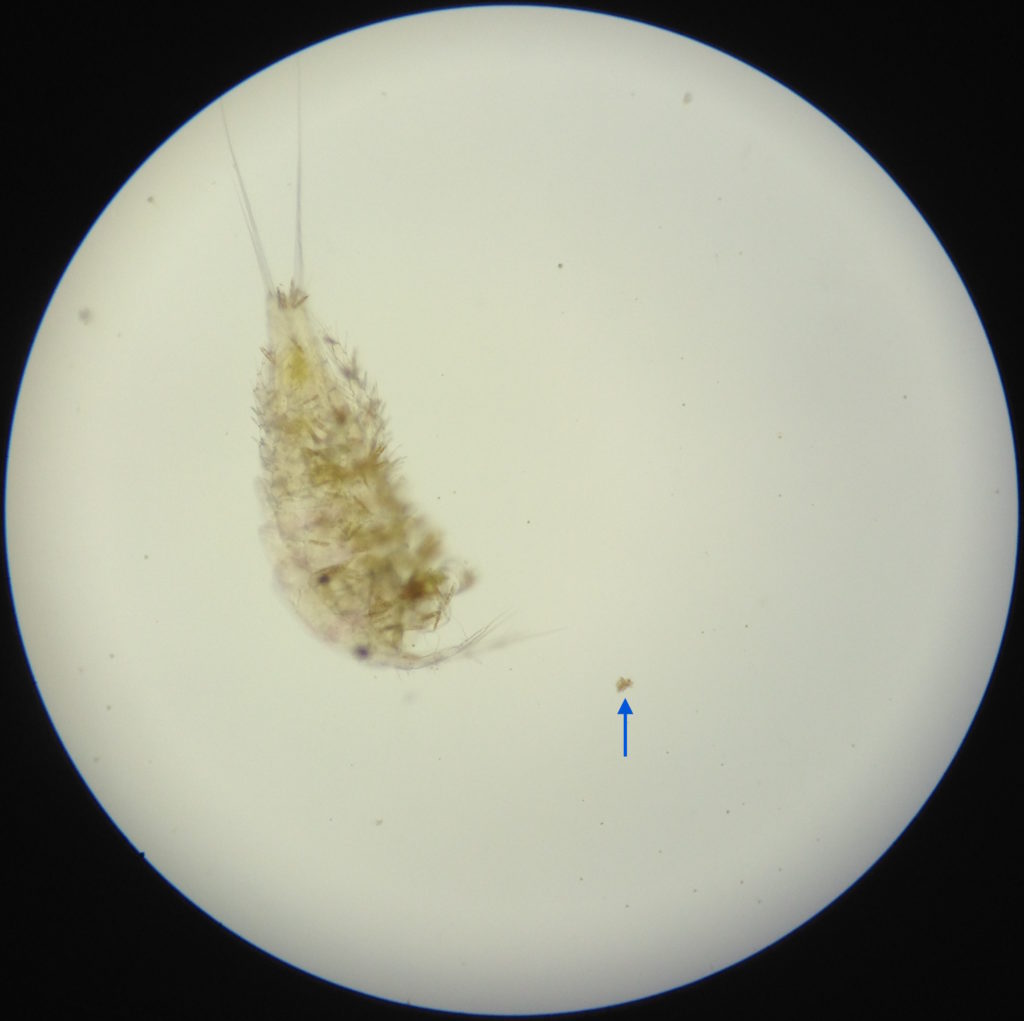 FIGURE 3: Size difference between Tigriopus californicus adult (left) and egg (blue arrow; lysed) from Poseidon’s Feast product line at 100X. Poseidon’s Feast bags are gas-permeable and include nutrients to maximize pod growth during shipping and storage.
FIGURE 3: Size difference between Tigriopus californicus adult (left) and egg (blue arrow; lysed) from Poseidon’s Feast product line at 100X. Poseidon’s Feast bags are gas-permeable and include nutrients to maximize pod growth during shipping and storage.
Because pods have the potential to progress through their growth cycles—during transportation and storage or while in the fish tank—knowing the total count is more helpful than simply having a few large pod sizes catch your attention. So, the bags of both Company A and B could contain the same number of pods, but one might contain a greater number of eggs and copepodites while the other might contain a greater number of mature pods.
In this white paper, we illustrate one way to estimate pod counts by showing how AlgaeBarn determines pod densities in its Poseidon’s Feast copepod blend product line.
1 Also AlgaeBarn, LLC, 2015
ESTIMATING COPEPOD COUNT [SUMMARY]
The number of pods in a container can be estimated by counting the number of pods from a small sample and, through a series of proportions, calculating an estimate of the pod number in the entire population (FIGURE 4).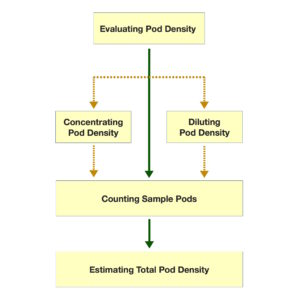 FIGURE 4: Overall approach to determining a pod count estimate. A sample count from a container of pods usually can be directly used to estimate the total population number of pods (green arrows). If desired, the pod solution could first be either concentrated or diluted before counting if the solution is too light or dense, respectively (orange arrows). The concentration or dilution factor would need to be accounted for during estimations.
FIGURE 4: Overall approach to determining a pod count estimate. A sample count from a container of pods usually can be directly used to estimate the total population number of pods (green arrows). If desired, the pod solution could first be either concentrated or diluted before counting if the solution is too light or dense, respectively (orange arrows). The concentration or dilution factor would need to be accounted for during estimations.
A compound light microscope with at least 40X magnification, which can be used to visualize pods of all sizes—from nauplii to adults—should be used. It is important to note that these methods only account for visible pods. Because eggs and early stage copepod nauplii are excluded, the actual number of pods is likely to be even greater than the estimate.
Evaluating Pod Density
The pod solution should first be inspected to see whether or not it is at an optimal density—not too many nor too few pods —for counting. After the pod solution is shaken well, a 0.1mL sample is dispelled onto a microscope slide; a 1mL syringe may be used to do this. Under 40X, the entire sample is inspected through the limited field of view of the eyepieces to evaluate pod density.
If the container of pods being used is too dilute (i.e. you see too few pods in the sample under 40X; e.g. fewer than 3pods/0.1mL), then the solution should be concentrated and the concentration factor should be accounted for in the estimations; see “Concentrating Pod Density.” On the other hand, if the container of pods being used is too dense (i.e. you see too many pods in the sample; e.g. more than 15pods/0.1mL), then the sample should be diluted and the dilution factor should be accounted for in the estimations; see “Diluting Pod Density.” If neither concentrating nor diluting is necessary, then the pods are ready to be counted; see “Counting Sample Pods” directly. Before proceeding to any section, the pod solution volume (in mL) should be recorded; a graduated cylinder may be used for measuring (ensuring to lose as few pods as possible while transferring back and forth).
Note that the suggested optimal pod density of 3-15 pods/0.1mL sample solution may be a good starting point, but ultimately the optimal density will be based on the number of pods/0.1mL you are comfortable with keeping track via the microscope.
CONCENTRATING POD DENSITY
While a good starting point is to concentrate by a factor of 2, applying the following equation will allow you to use any concentration factor: One way a concentration factor of 2 could be achieved is by filtering exactly 1⁄2 of the original solution volume (as measured by the graduated cylinder) through a mesh filter (e.g. 50μm)— capturing all pods while removing liquid. Once the captured pods have been transferred back into the remaining solution, the remaining volume (now the concentrated volume) could then be verified with the graduated cylinder, which should be 1⁄2 less than the original volume.
One way a concentration factor of 2 could be achieved is by filtering exactly 1⁄2 of the original solution volume (as measured by the graduated cylinder) through a mesh filter (e.g. 50μm)— capturing all pods while removing liquid. Once the captured pods have been transferred back into the remaining solution, the remaining volume (now the concentrated volume) could then be verified with the graduated cylinder, which should be 1⁄2 less than the original volume.
DILUTING POD DENSITY
While a good starting point is to dilute by a factor of 2, applying the following equation will allow you to use any dilution factor: The pod solution could be diluted by a factor of 2 by adding clean saltwater (sp. gr. 1.025) into the pod container equal to the volume of the original solution (as measured by the graduated cylinder). The diluted volume could then be verified with the graduated cylinder, which should be twice as much as the original volume.
The pod solution could be diluted by a factor of 2 by adding clean saltwater (sp. gr. 1.025) into the pod container equal to the volume of the original solution (as measured by the graduated cylinder). The diluted volume could then be verified with the graduated cylinder, which should be twice as much as the original volume.
COUNTING SAMPLE PODS
At this point, the pod solution should be at an ideal density for counting, either from concentrating (proceeding from “Concentrating Pod Density”) or diluting (proceeding from “Diluting Pod Density”), or because it was already at an ideal density (proceeding from “Evaluating Pod Density”).
In order to count pods efficiently, they should first be immobilized. One way to do this is to mix the pod sample to be counted in an alcohol solution: after the pod solution is shaken well, a 0.1mL sample is mixed with 20μL of rubbing alcohol—transferred via pipette—in a microcentrifuge tube. The alcohol and pod sample mixture is dispelled onto a microscope slide. The goal this time is to pass and inspect every part of the sample through the limited field of view of the eyepieces, counting and recording down the number of every pod seen (in pods/0.1mL). Once counting is complete, the microscope slide is wiped clean and the process of immobilizing and counting a 0.1mL sample of pods is repeated several more times; having more trials will ensure a more accurate total pod estimate. While sampling without replacement is used, the volume of pods and solution removed in each trial relative to the entire container volume is so little that the effect would likely be negligible to the overall pod estimate.
ESTIMATING TOTAL POD DENSITY
Once several trials of sample pod counts have been completed, the numbers will be used to calculate an estimate for the pod count of the entire pod solution (FIGURE 5).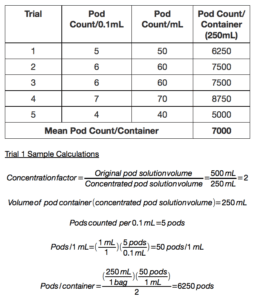 FIGURE 5: Sample calculations for determining a pod count estimate. As shown with arbitrary numbers, an overall estimate of pod count/bag can be determined using proportions with pod count/0.1mL. The above calculation shows a scenario in which the pod solution is concentrated before counting to illustrate how a concentration factor might be used. Sample calculations for other trials are similar to those of trial 1.
FIGURE 5: Sample calculations for determining a pod count estimate. As shown with arbitrary numbers, an overall estimate of pod count/bag can be determined using proportions with pod count/0.1mL. The above calculation shows a scenario in which the pod solution is concentrated before counting to illustrate how a concentration factor might be used. Sample calculations for other trials are similar to those of trial 1.
For each trial, the pod count/0.1mL (from “Counting Sample Pods”) is multiplied by 10 to compute a pod count/mL. The pod count/mL is then multiplied by the total volume of the pod solution (from either “Evaluating Pod Density,” “Concentrating Pod Density,” or “Diluting Pod Density”). If the pod solution has been concentrated, then the product [(pod count/mL)(total volume of the pod solution)] is divided by the concentration factor; if the pod solution has been diluted, then the product is multiplied by the dilution factor. A pod count/container will thus be computed for each trial, and an average pod density estimate may be calculated by finding the mean of the pod count/container estimates.
CONCLUSION
When purchasing pods, we often leap at the first sight of great size, frequently overlooking both the variety and number. While size is certainly proportional to nutrition content, it is more useful to bear in mind that pods have considerable differences in sizes and growth is continuous even during storage. Thus, the copepod population density is an invaluable figure in determining the overall nutrition content in a container of pods. Using the methods in this white paper will allow fish owners to make more informed decisions when purchasing pods.
AlgaeBarn consistently uses these methods to ensure the variety and pod density in each bag of Poseidon’s Feast.
References
1 Pinto, C., Souza-Santos, L., & Santos, P. (2001). Development and population dynamics of Tisbe biminiensis (Copepoda: Harpacticoida) reared on different diets. Aquaculture, 198(3-4), 253-267. doi:10.1016/S0044-8486(00)00582-2
2 Powlik, J., Lewis, A., & Spaeth, M. (1997). Development, body length, and feeding of Tigriopus californicus (Copepoda, Harpacticoida) in laboratory and field populations. Crustaceana, 70(3), 324-343. doi:10.1163/156854097X00609
AlgaeBarn, LLC
5900 E. 58th Avenue,
Suite A
Commerce City, CO 80022
www.algaebarn.com | Sales: support@www.algaebarn.com
© 2015-2019 AlgaeBarn, LLC. All rights reserved.


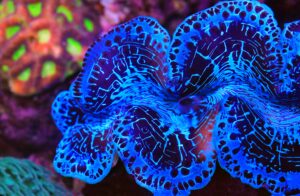
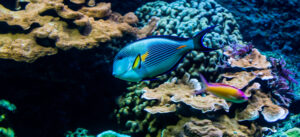

Kristy Chambers says
This blog was sooo interesting and informative! Thank You guys for putting your all in it! I love your passion!!
Another Satisfied Customer ?
Noah says
?
Stefan Bladen says
Thanks for the write up
Anthony says
Awesome article. Answered a great question regarding a reefing necessity for coral and fish.
Jon Dimitri Andrianos says
Same here
Christoph Halverson says
Totally agree
robert vice says
I believe there in there I’ll take your word for it just because of the success I’ve had with your product
esear14 says
educational
Tony Mutti says
I’ll just take your word for it.
Josh hiltabiddle says
More than I can count
devon says
so many pods
Terrence Harrison says
Very informative and educational!
artaa1988 says
great info
Mohamed says
Informative thread
James says
Great article I always wondered how it was done
Carl Brown says
Good read
Allen Fagard says
Good info
mikerosa1965 says
great article with helpful information
Tiffanie says
I always get my pods from you!
Andy says
This is very helpful information. Thanks!
Alex says
Very interesting awesome info
Brandi says
I like that you compared the size of adult and eggs.
Christopher Burns says
algeabarn is the best
Tara says
Didn’t know they were there at first.
Hailey Weir says
Haileyweir46173@gmail.com
Sean Simkins says
This.
professorcanswanky says
Amazing info
ANDREW WELSH says
Very informative!
Ross Bennett says
Very interesting
David says
I always wondered if I was getting anything for the money I was paying. Now I know.
Doug Smith says
not all pods are created equal. Algae Barn pods are best.
darksorcerer0530 says
Man, this is the type of problem that your math teacher warns you about.
Angela Revell says
Love it
Marc Raupp says
fascinating article. thank you for sharing this with us. i look forward to more.
Juan Gonzalez says
Love seeing all the different sized pods before adding them to the tank. Thank you Algaebarn for the informative read.
Anchor Sarslow says
Great information, thank you
Anthony Ferrelli says
? I’ll just trust you.
George says
Good Info!
jeffreyfelter says
I just have to take the word on the package because my eyes are getting bad.
Michael Kessler says
Interesting
Andrew Bilodeau says
A lot of info to take in, but I love it!
Christopher says
You guys know your thing
Savoury Kem says
Whoa
Deborah Najm says
Looking forward to seeing their success in our tank
Tim Jones says
Pods for days
Ricardo munoz says
Good info
erik says
great stuff
Gino says
Thank you!
James says
Cool
garethb9 says
So informative! Love learning new things
Brent Cox says
Very helpful information.
Robert Paniagua says
Awesome guide
brent says
What assumptions are used to derive the above formula? Is there a model you’re running in the background?
good stuff, keep it coming!
John Worthington says
Very interesting read thank you for the information
Tom Giddens says
tough job
John key says
I wondered how that was done. I always thought is was just a guesstimate lol. Nice to know that effort is put in!
Kristoffer Hamann says
Now this is interesting.
danieoue says
Very interesting thank
Sean Beaver says
Very informative.
Itzel says
They give me the heebie jeebies
blk250r says
Thank you, back in school. Nice
Ellen S Imbrie says
thanks for posting
Kristopher Kasarda says
Great information!
Derek says
Great info!
chrissyhexd says
Wow!!!
Justin says
Good info
Jeremy Hunsberger says
Sweet
Bennett Sheppard says
This blog truly puts everything into perspective and let’s us truly see the value in purchasing from Algae Barn!
Martin Gundel says
Very nice read as I’m culturing mine right now.
William Schimmel says
Sweet
btack206 says
Who knew there was gonna be this kind of math in keeping an aquarium!!
Ryan M. Vaughan says
Helpful
Branden Hess says
Very useful.
stoph70 says
interesting
glenzemke says
Wow. Very interesting
Frank says
I always get pods from Algae Barn
Logan Kreider says
Good read
Kyle Frame says
Wow…alot of things I didn’t know about pods. Thanks for the info
Nicholas says
Nice
Jose Pacheco says
fascinating article
Jesus says
Good to know
Dylan says
Good to know!
Ricardo Munoz says
Quality info, thanks for the very informative article. Definitely makes reefing a lot more simple!
Stefan Bladen says
Way to complicated I’ll just stick with you guys
Stefan Bladen says
Wow
Lisa says
Excellent info as always Algea Barn!
castrommaritza says
Good to know. Need to start this up again